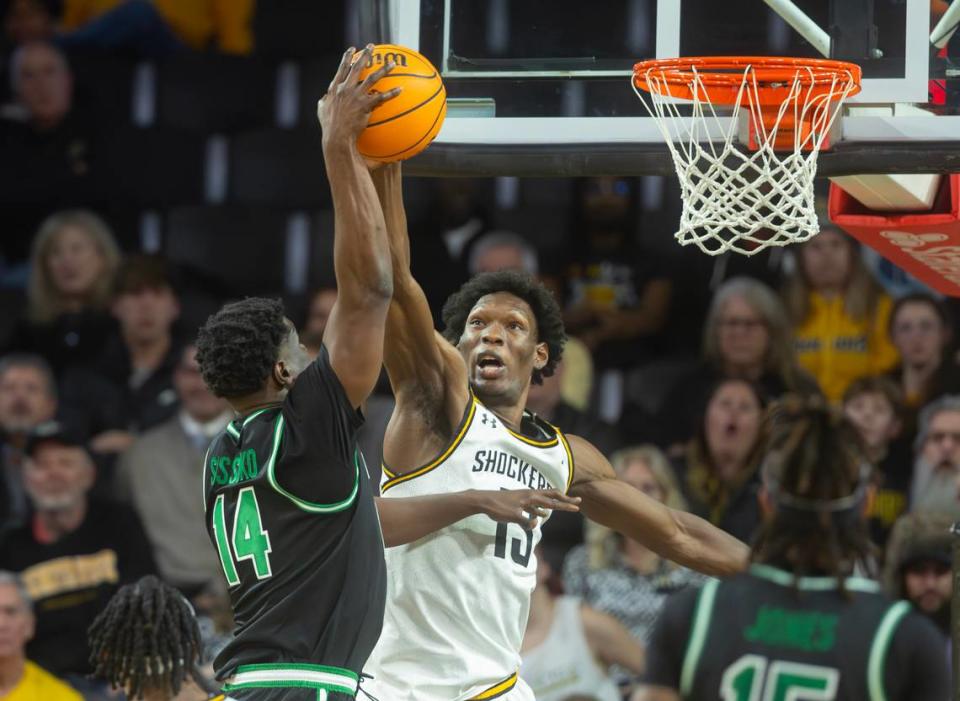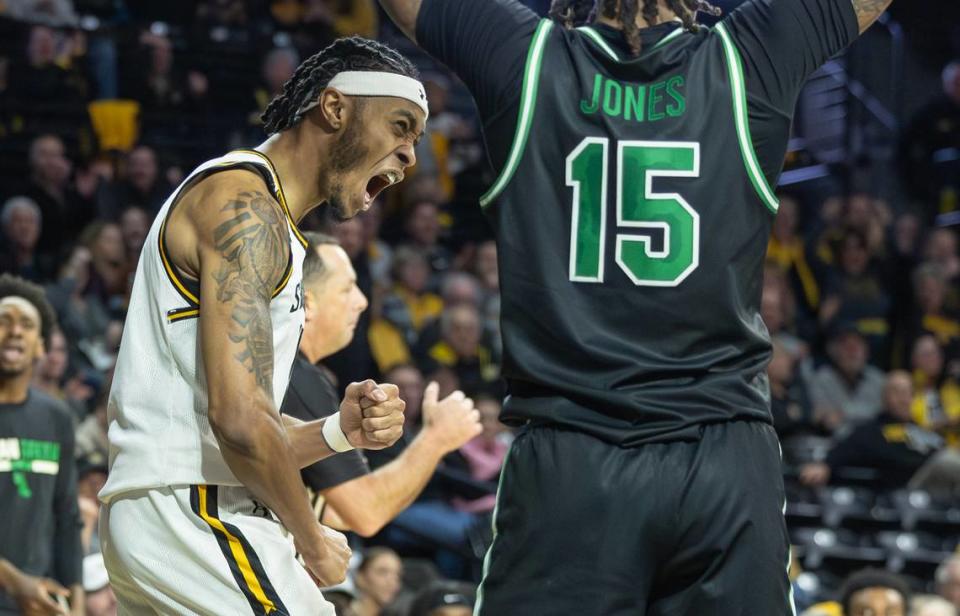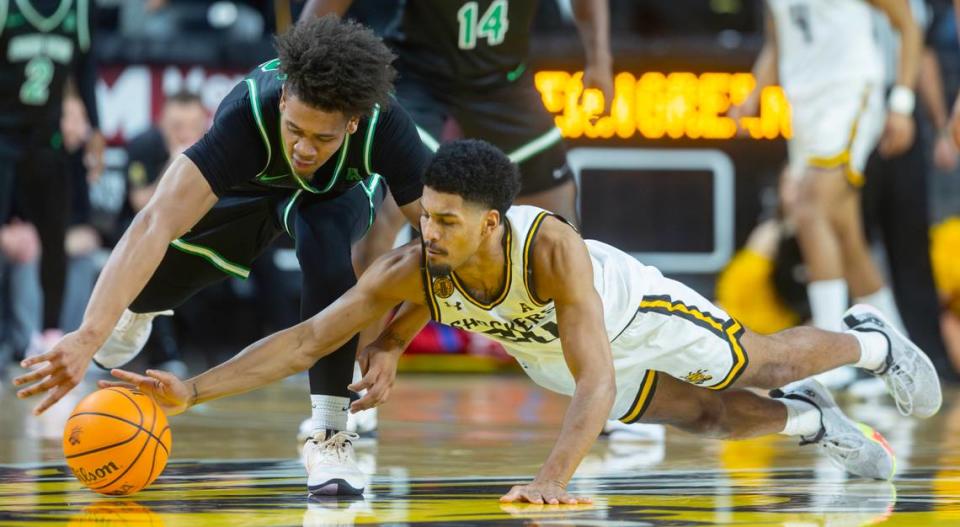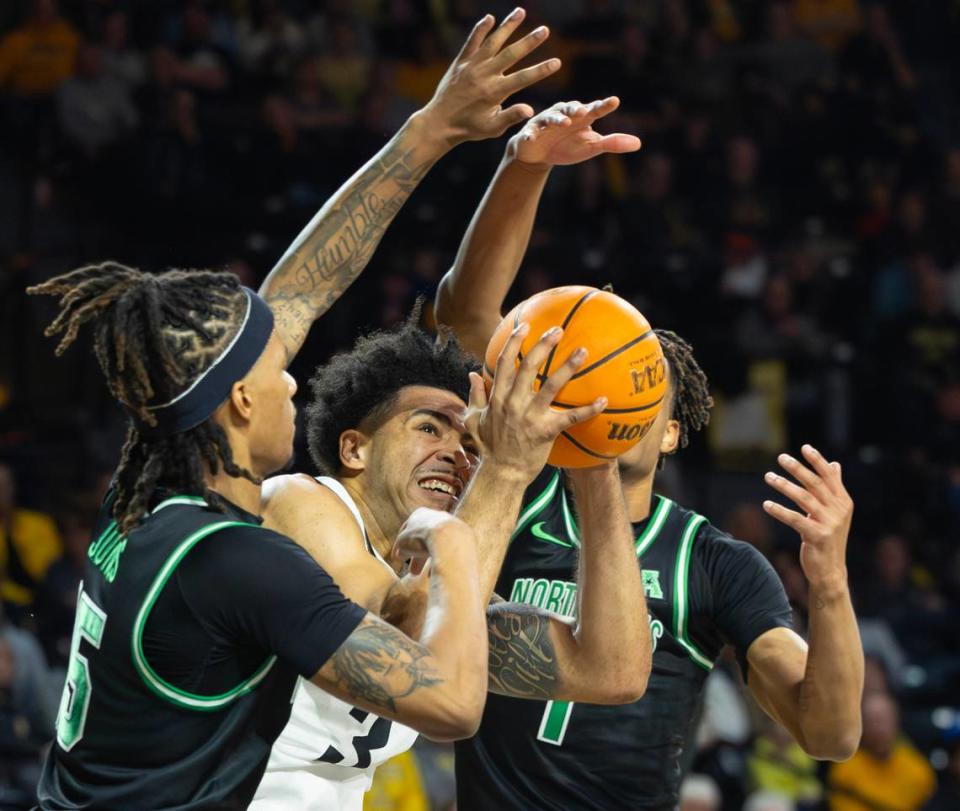Shocker film room: How Wichita State lost the North Texas game early with bad habits
- Oops!Something went wrong.Please try again later.
It’s difficult to say with certainty a basketball game can be lost in the first eight minutes, but that very well could have been the case for Wichita State on Thursday.
Perhaps there was a chance for the Shockers to recover from their 15-point deficit to North Texas before the second media timeout, but their margin for error was all but eliminated.
Few teams are equipped to operate like that, but especially not this WSU team.
That’s why it’s worth examining what went wrong for Wichita State in those opening eight minutes in what became a 74-62 loss to North Texas at Koch Arena.
Some common themes have emerged in the last five defeats for WSU, which presents the road map for what the Shockers need to correct to get back on track under first-year head coach Paul Mills.

Defensive miscues doom Wichita State in loss
In building a 26-11 lead just past the 12-minute mark in the first half, North Texas scored on 11 of its first 14 possessions, made 9 of 13 shots and generated 1.86 points per possession.
WSU’s defense logged just three stops in the first eight minutes of the game, an already minuscule number that becomes even more troubling considering the Mean Green manufactured wide-open 3-pointers for good shooters on two of those possessions.
North Texas scored 26 points on its first 14 possessions (1.86 PPP) of the game.
WSU played good D on opening possession, but after that, troubling Shockers only had 2 defensive stops and these were the 2 - on plays that UNT still manufactured wide-open 3s. pic.twitter.com/n9kjSKmEC1— Taylor Eldridge (@tayloreldridge) January 5, 2024
With the chance to halt its poor play from the month of December, WSU came out in Thursday’s game with the same bad habits.
“Our intensity wasn’t where it needed to be,” WSU junior Colby Rogers said. “You can’t spot guys open shots. This is high-level basketball. They’re going to make threes if you give it to them. We just didn’t come out with the right intensity, the right attention to detail and they made us pay for it.”
It’s difficult to properly evaluate defense without knowing WSU’s game plan, but it’s safe to say the Shockers blew defensive coverages multiple times to start the game.
Always hard to evaluate defense when you don't know the coverages in the game plan, but safe to say Wichita State blew a lot of coverages early in the game against North Texas.
Here's a look at how defensive miscues led to a handful of breakdowns in the first 8 minutes. pic.twitter.com/9QUPZM2COn— Taylor Eldridge (@tayloreldridge) January 5, 2024
Whether it was lack of communication or lack of execution from the scouting report, WSU’s defense committed a series of miscues in the opening eight minutes that gave North Texas an assembly line of high-quality looks.
Mills was particularly disturbed that UNT sharpshooter Jason Edwards, who WSU game-planned to take away 3-point shots entirely, attempted six 3-pointers in the first half alone. Even though Edwards only shot 2-of-7 beyond the arc, Mills was disappointed in WSU’s execution of the game plan.
“It’s not all on the players, it’s definitely on us as coaches,” Mills said. “We need to do a good job of explaining the urgency of getting to shooters. Edwards, he can’t shoot six threes in the first half. No way. You can’t even give a guy like that attempts because that’s what he does.
“We need to do a better job and that’s on us as coaches to play the people who are going to get out there and embrace that.”

Wichita State’s offense has a shooting-gravity issue
The hard lesson WSU is learning in the first half of this season is that no matter how well it spaces the floor around the 3-point line, it doesn’t always matter because the defense is rarely concerned about the players around the arc.
Shooting gravity has become a popular phrase in the basketball world to describe this phenomenon. If a player has strong shooting gravity, like Colby Rogers, every move impacts the defense, even without the ball, and can help generate better looks for teammates.
Take out Rogers’ 38% accuracy beyond the arc and the rest of WSU is shooting 25% on 3-pointers against Division I competition this season. In other words, WSU has no shooting gravity outside of Rogers, which made it easier for North Texas to clog the lane and prevent WSU’s bread-and-butter source of scoring.
“I was super proud of our guys because our game-plan discipline was really high,” North Texas coach Ross Hodge said. “We knew where our help was going to come from. You can’t guard those guys 1-on-1. You can’t guard Bell and Rogers because they do such a good job of getting in the paint. So we kind of identified some areas we wanted to force them to where we would have help. Our guys did a great job executing it and sometimes it’s a make-or-miss game and they had some good looks and just missed.”
Simply put, WSU has very little shooting gravity outside of Colby Rogers, which makes it easier for defenses to load up its help in the paint.
Here's 2 good examples of how North Texas squeezed the paint & sagged off to prevent penetration. Right now WSU not making teams pay. pic.twitter.com/vHK4IuUXYv— Taylor Eldridge (@tayloreldridge) January 5, 2024
WSU’s lack of shooting gravity was never more than clear than when Rogers had the ball against North Texas. No matter who was opposite of him, the Mean Green had their other wing defenders sag off to block off potential driving gaps and prevent Rogers from getting to his spots where he likes pull-up jumpers.
If Rogers makes the right basketball play and kicks to the open player, WSU is either not attempting the 3-pointer or shooting it at a very low percentage. Simply put, the Shockers don’t make opponents pay often enough.
That’s why Mills has chosen to clear one side of the floor and allow Rogers to attack in isolation so much this season, as his 1-on-1 scoring is often WSU’s best chance at points.
But even Rogers knows iso scoring can’t be the main driver of the offense. Even without good outside shooting, WSU can still generate quality offense — but it needs better player and ball movement.
“With our personnel, we have to make defenses shift,” Rogers said. “At this level, you’ve got to make teams move, make teams shift on defense and attack the gaps, attack close-outs and things like that. I don’t think going 1-on-1 is going to be beneficial for us.”

Live-ball turnovers plague the Shockers
Not only has WSU’s turnover rate continued to rise in its last five losses, but the Shockers continued to be plagued by the most costly — live-ball turnovers that directly lead to fast-break points for the opposition.
Gregg Marshall used to refer to those mistakes as “atomic bombs” and they have increased in frequency lately for the Shockers.
In its last five losses, WSU has essentially turned the ball over on one-fifth of its possessions (14.4 turnovers per game at a 19.9% rate). Live-ball turnovers decimated WSU’s transition defense in losses to Missouri, South Dakota State and Kansas and once again popped up in Thursday’s loss to North Texas.
“You never want to turn the ball, but if you do, you want them to be dead-ball turnovers so you can set up your defense,” WSU guard Colby Rogers said. “We have to limit live-ball turnovers and bad shots can act like turnovers in some ways. We have to be smarter with the ball, tougher with the ball.”
Once again "atomic bomb" turnovers plagued Wichita State.
These are live-ball turnovers that lead directly to opponent points at the other end on fast breaks.
Not only is WSU's turnover rate high in its last 5 losses, the number of these type of turnovers has skyrocketed. pic.twitter.com/uIAtKwsrJX— Taylor Eldridge (@tayloreldridge) January 5, 2024
The first costly live-ball turnover occurred when Bijan Cortes tried to whip a one-handed, cross-court pass that was deflected and then stolen by CJ Noland for what ultimately led to an uncontested dunk by Aaron Scott at the other end for a 17-11 lead.
On the very next possession, Harlond Beverly tried to squeeze a bounce pass into a tight window to Rogers and North Texas again came away with a steal. This time, Scott earned two free throws at the other end attacking WSU’s compromised defense.
Eliminating catastrophic turnovers like those not only can boost WSU’s offense, but also its defense moving forward. Cortes said it has been a point of emphasis from the coaching staff.
“I’ve got to try to find the right pace and stick to the offense and just try not to do too much,” Cortes said. “Not trying to make the home-run play. Coach says that all of the time, not trying to make the home-run play and just make the simple play and create for others without the dumb mistakes.”

Mismatch nightmare haunts Wichita State’s defense
It was always going to be a difficult ask for WSU 6-foot-11 junior Kenny Pohto, who covered centers before this season, to guard North Texas 6-foot-7 stretch forward Aaron Scott.
Mills seriously considered a lineup change for Thursday’s game, but ultimately stuck with his two-center starting lineup and gambled Scott, who was a 40% 3-point shooter but just 2-of-11 on triples in six December games, wouldn’t regain his outside-shooting form.
That plan went up in flames by the first media timeout, as Scott torched WSU on three 3-pointers — all on pick-and-pop plays where the close-out distance was too much ground for Pohto to make up.
“Scott is a good shooter, but if you look at his last five games, those aren’t shots that were necessarily falling for him,” Mills said. “You’ve got to give him credit.”
UNT stretch 4 @Aaronnscott1 torched WSU for 3 pick-and-pop 3s in first 4 minutes. Tough ask for Pohto to cover that much ground on D.
Loved set play @coachrosshodge dialed up to get Scott his third 3: another PNP, but this time with flare screen to make the recovery even harder. pic.twitter.com/NpDENHeMQW— Taylor Eldridge (@tayloreldridge) January 5, 2024
WSU uses Pohto in drop coverage defending ball screens, which means his job is to prevent dribble penetration by staying back in the paint when his man goes to set a screen.
It’s an effective strategy when defending a big man who likes to roll to the basket, but it put Pohto in a bind on Thursday when Scott would shuffle a few feet to the side and spot up for a 3-pointer. By the time Pohto recovered to challenge the shot, Scott’s release was gone.
North Texas coach Ross Hodge exploited WSU’s drop coverage again for Scott’s third 3-pointer. This time when Scott popped, he also received a flare screen set by Quincy Ballard’s man to make Pohto’s recovery even longer. Because Ballard also was in drop coverage, he was not in position to help Pohto, which left Scott free to fire away and give the Mean Green an early boost in the game.
“Our guys did a really good job of executing what we were trying to do,” Hodge said. “But like anything, you’ve got to make the shots. And (Scott) made them. He made a couple of tough ones too.”

